Berberis thunbergii 'Tiny Gold' (PBR)
ABOUT
Berberis thunbergii 'Tiny Gold', commonly known as the Japanese barberry, is a deciduous shrub known for its attractive foliage and compact growth habit. Its most distinguishing feature is the vibrant golden-yellow leaves that catch the eye and bring a splash of brightness to any setting. The small, rounded leaves delicately line the thorny branches, which become more intense in color when exposed to full sunlight, providing a stunning contrast against the darker greens often found in garden landscapes. During the spring, the Japanese barberry may produce small, yellow flowers, which dangle delicately along the lengths of the branches. These blooms can add an extra touch of interest and are sometimes followed by tiny, red berries by fall, adding to the plant's ornamental value. The berries can last into the winter, offering a slight, but notable, visual appeal even as the temperatures drop. The plant's thorns make it a good choice for those seeking a natural deterrent or a barrier plant, albeit care should be taken when planting in areas frequented by children or pets. Throughout the seasons, the foliage may undergo subtle changes in hue, providing an evolving display that keeps the plant interesting throughout its growing cycle. The Japanese barberry's overall form is dense and mounded, making it a versatile addition to the landscape where it serves as an excellent low-maintenance choice, ideal for borders, hedges, or as a standalone feature in a garden design.
About this plant
 Names
NamesFamily
Berberidaceae
Synonyms
Japanese Barberry, Thunberg's Barberry
Common names
Berberis thunbergii 'Tiny Gold' (PBR)
 Toxicity
ToxicityTo humans
The most common common name of Berberis thunbergii 'Tiny Gold' (PBR) is Japanese Barberry. This plant is not typically known to be highly toxic to humans. However, like many plants, parts of it may cause irritation or mild stomach upset if ingested. It is always recommended that humans refrain from eating ornamental plants as they are not intended for consumption. There are no widespread reports of severe poisoning or fatal consequences associated with this species among humans from ingestion.
To pets
Japanese Barberry is not commonly listed as highly toxic to pets. However, as with humans, it can potentially cause mild gastrointestinal upset if ingested by pets, like dogs or cats. Symptoms of poisoning may include vomiting or diarrhea. Although not typically life-threatening, it is still advisable to prevent pets from consuming plant material, as individual animals might have different sensitivities or allergic reactions.
 Characteristics
CharacteristicsLife cycle
Perennials
Foliage type
Deciduous
Color of leaves
Yellow
Flower color
Yellow
Height
2 feet (60 cm)
Spread
2 feet (60 cm)
Plant type
Shrub
Hardiness zones
4
Native area
Japan
Benefits
 General Benefits
General Benefits- Drought Tolerance: Once established, it has good drought resistance, requiring minimal watering in dry periods.
- Compact Size: Its small stature makes it suitable for use in smaller gardens or confined spaces.
- Low Maintenance: Requires little pruning or care once established, ideal for busy or novice gardeners.
- Seasonal Interest: Offers bright, golden-yellow foliage that provides visual interest throughout the growing season.
- Winter Hardiness: It's a hardy plant that can withstand cold temperatures, making it suitable for a variety of climates.
- Deer and Rabbit Resistant: Less likely to be damaged by deer and rabbits, which can be beneficial in areas where wildlife browsing is an issue.
- Attractive to Pollinators: Although not its primary benefit, it can attract bees and other beneficial insects when it blooms.
- Landscape Versatility: Can be used for border edging, low hedges, mass plantings, or as a colorful accent in the landscape.
- Year-round Beauty: Evergreen in many climates, providing year-round color and structure to the garden.
- Easy to Propagate: Can be easily propagated by cuttings, making it simple to create more plants for other areas of the garden.
 Medical Properties
Medical PropertiesThis plant is not used for medical purposes.
 Air-purifying Qualities
Air-purifying QualitiesThis plant is not specifically known for air purifying qualities.
 Other Uses
Other Uses- Photography Prop: The vibrant foliage of the Japanese barberry 'Tiny Gold' can create a stunning backdrop or focus point in macro photography, providing a pop of color and texture.
- Foliage Collection: Hobbyists who collect and press leaves can use its uniquely colored leaves for art projects or herbariums.
- Thematic Gardens: This plant can be used in storytelling or themed gardens, such as fairy or miniature gardens, due to its small stature and bright foliage.
- Garden Borders: This low-growing shrub can serve as an aesthetic and color contrast when used in garden borders along with other plants that feature darker foliage.
- Wildlife Shelter: While not its main purpose, the dense foliage can provide shelter to small birds and beneficial insects within the garden ecosystem.
- Reference Material: Educators and students can use the plant to study and discuss the impact of invasive species in new ecosystems.
- Seasonal Decorations: Branches trimmed from the Japanese barberry 'Tiny Gold' can be incorporated into autumn and winter floral arrangements or wreaths.
- Nature Crafts: The branches and leaves can be used in crafting activities for children, like making natural collages, crown-making, or fairy garden accessories.
- Color Contrast in Rock Gardens: Planted among a rock garden, the bright golden leaves can provide a striking contrast against the stones.
- Land Art: Artists who work with natural landscapes to create temporary or permanent installations can use the vibrant hues of the 'Tiny Gold' to add color and structure to their pieces.
Interesting Facts
 Feng Shui
Feng ShuiThe Japanese Barberry is not used in Feng Shui practice.
 Zodiac Sign Compitability
Zodiac Sign CompitabilityThe Japanese Barberry is not used in astrology practice.
 Plant Symbolism
Plant Symbolism- Protection: Berberis thunbergii, commonly known as Japanese barberry, is often associated with protection. Its sharp thorns have traditionally been seen as a natural barrier against negative forces and intruders.
- Adaptability: The adaptability of the Japanese barberry to different soil types and environments symbolizes flexibility and the ability to thrive in various conditions.
- Longevity: Japanese barberry plants are known for their hardiness and longevity, symbolizing endurance and the passage of time.
 Water
WaterThe Japanese Barberry 'Tiny Gold' should be watered deeply to ensure the root zone becomes moist, with an interval of once a week during the growing season for established plants, and possibly more frequently for newly planted ones until they become established. In general, depending on climate and weather conditions, you may provide about 1 to 1.5 gallons of water weekly, but this should be adjusted based on rainfall and soil drainage. During the winter or in periods of rainfall, reduce watering to prevent overwatering which can lead to root rot. It's important to avoid overhead watering to reduce the risk of foliage diseases. Always check the soil moisture level a few inches down; if it's dry, it's time to water.
 Light
LightJapanese Barberry 'Tiny Gold' prefers full sun to partial shade, with at least 6 hours of sunlight each day being ideal to ensure good foliage color and overall health. If planted indoors, place it near a south-facing window or under grow lights to mimic these conditions. While it can tolerate a range of lighting conditions, too much shade will result in less vibrant foliage and a reduced number of blooms.
 Temperature
TemperatureJapanese Barberry 'Tiny Gold' is hardy and can withstand a wide range of temperatures, thriving best in temperatures between 50°F and 75°F. It is capable of surviving winter temperatures down to -30°F, but should be protected from extreme cold with mulching if planted in a pot. During the hot summer months, ensure it has adequate water to prevent heat stress.
 Pruning
PruningPruning the Japanese Barberry 'Tiny Gold' is essential to maintain its shape and encourage bushier growth. Pruning should be done in late winter or early spring, before new growth begins. Remove any dead or damaged branches, and thin out the center of the plant to improve air circulation. Pruning can be performed annually to shape the plant and keep it compact.
 Cleaning
CleaningNot needed
 Soil
SoilJapanese Barberry 'Tiny Gold' prefers well-draining soil with a pH of 6.0 to 7.5. A mix of garden soil, peat, and perlite or sand will ensure proper drainage and aeration. Amend the soil with compost for added fertility.
 Repotting
RepottingJapanese Barberry 'Tiny Gold' typically requires repotting every 2-3 years. Best done in late winter or early spring before new growth starts.
 Humidity & Misting
Humidity & MistingJapanese Barberry 'Tiny Gold' is tolerant of a wide range of humidity levels. It thrives in average outdoor humidity, making it versatile for most garden settings without specific humidity requirements.
 Suitable locations
Suitable locationsIndoor
Place in bright light and keep soil moderately dry.
Outdoor
Plant in sun-partial shade; mulch root zone.
Hardiness zone
5-8 USDA
 Life cycle
Life cycleThe life of the Barberry 'Tiny Gold' begins with seed germination, which occurs under favorable conditions of moisture and temperature, generally in spring. After germination, the seedling emerges and establishes itself, developing a root system and foliage. The juvenile phase follows, where the plant experiences rapid vegetative growth; this period can vary in length. As the plant matures, it enters the reproductive stage, characterized by the development of flowers that attract pollinators and result in the production of small, berry-like fruits that carry seeds. These fruits mature, and when they drop to the ground or are dispersed by animals, they have the potential to generate new plants if conditions are suitable. Finally, after several years, the plant will reach the end of its life cycle and die, but by this time, it may have produced numerous offspring to continue the species.
 Propogation
PropogationPropogation time
Spring-Early Summer
The Japanese barberry 'Tiny Gold' is commonly propagated by softwood cuttings. The ideal time for taking cuttings is in late spring or early summer when new growth is still flexible. To take a softwood cutting, select a healthy, non-flowering shoot and cut a 4- to 6-inch (10-15 cm) length, making sure there are at least two sets of leaves. Strip the leaves from the lower half of the cutting and dip the cut end in a rooting hormone. The prepared cutting should then be placed in a well-draining rooting medium, such as a mix of peat and perlite. The cutting needs to be kept moist and in a warm environment with indirect light until roots develop, which typically takes a few weeks. After rooting, the new plants can be gradually acclimated to outdoor conditions and eventually transplanted to their permanent location.

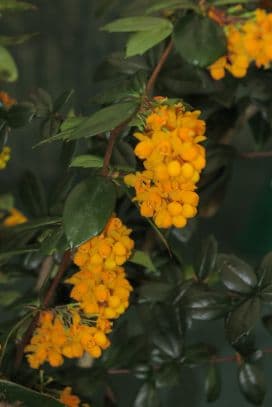
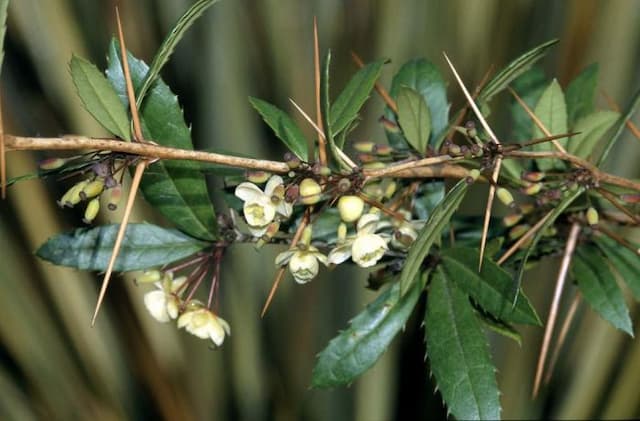
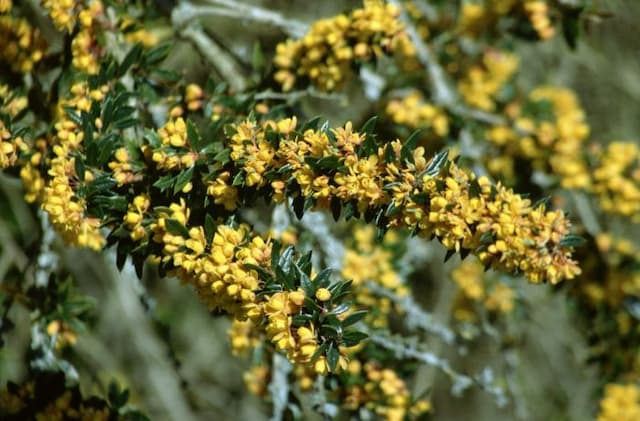
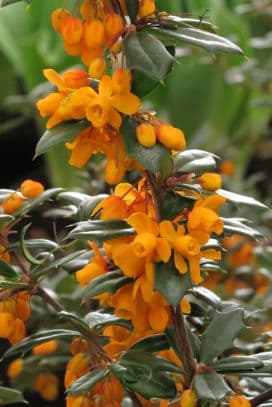
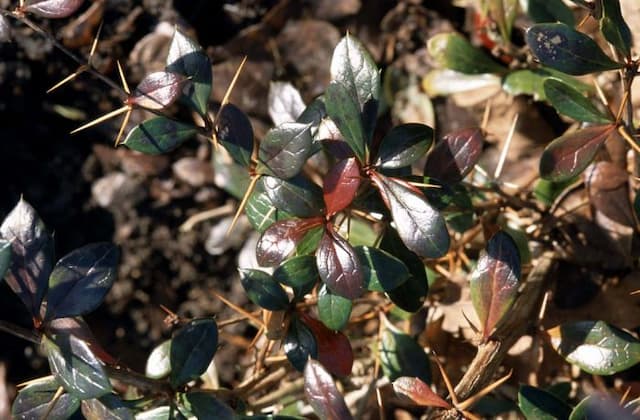


![Japanese barberry [Bonanza Gold]](/_next/image?url=https%3A%2F%2Fplants-admin.emdemapps.com%2Fimages%2Fplants%2F%2Fimages%2F604b5385e413f.png&w=640&q=75)
